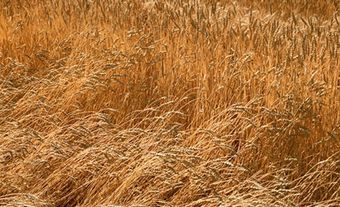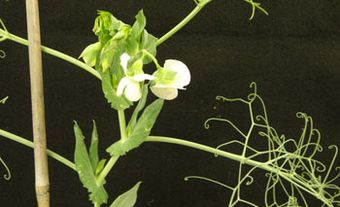History of Wheat in Canada
The first recorded plantings of wheat in Canada took place in 1605 at Port Royal (now Annapolis Royal, Nova Scotia). A small water-powered grist mill was operational around that time. Other recorded early plantings were in Quebec City by Louis Hebert in 1617. The subsequent spread of wheat production in Canada coincided with the movement of settlers westward. A planting of wheat was recorded at Fort St. Louis, west of Nipawin, Saskatchewan in 1754. A much larger planting was undertaken by the Selkirk settlers in 1812. The wheat seed planted in those days was brought over by the settlers from their country of origin and included varieties such as Club, Golden Drop, White Russian, Red Chaff and Ladoga. These varieties were not well adapted to Canadian growing conditions and were low yielding, late in maturity and inferior in baking quality. The introduction of Red Fife in 1842, with its improved yield and baking quality, increased the wheat acreage in Canada, leading to an acceleration of land development and expansion of the railway systems.
Wheat Variety Development
In 1886, Dr William Saunders, father of plant breeder Charles Saunders, was appointed director of the Experimental Farms Service and travelled extensively throughout Canada to monitor the adaptability of varieties of different crops. He noted that despite its attributes, Red Fife was somewhat late in maturity and thus would succumb to late fall frosts, especially in Western Canada. He also continued introducing wheat strains from other parts of the world and monitored their performance in plantings at Agassiz, BC; Brandon, Man.; Indian Head, Sask.; and Ottawa. He did not observe an obvious replacement for Red Fife among these plantings and realized he would have to produce a new wheat variety for Canadian growing conditions by combining the attributes of the various introductions. He noted that an introduction from India, named Hard Red Calcutta, matured 21 days earlier than Red Fife and was 28 cm shorter, but had a seed yield of less than half of that of Red Fife. In 1892, William Saunders sent his elder son Percy to Agassiz to make the cross between Hard Red Calcutta and Red Fife.
Plant breeding was a totally new science in those days. It amounted to making a cross and then creating a bulk of phenotypically uniform heads. Thus the varieties Markham A and Markham B (renamed Marquis A and Marquis B by 1906) were created from progenies of the Hard Red Calcutta and Red Fife cross. From these bulks, Dr. Charles Saunders began to select superior single heads. His selection criterion was to isolate a line that was earlier and stronger than Red Fife. To isolate a stronger type he initiated his famous chewing test, where he took several kernels from every selected head, and chewed these to make a dough ball. The dough ball with the greatest elasticity, he surmised, would identify the heads that had the greatest gluten strength, which would in turn give the largest loaf after baking.
Charles Saunders had a doctorate in chemistry, and likely knew the relationships between protein content, gluten strength and loaf volumes. In the dough preparation process, the yeast gives off carbon dioxide, which is prevented from escaping by a strong gluten; thus the dough rises to give a larger loaf volume. Wheat varieties with low gluten strength are used to produce cookies, crackers, doughnuts, breakfast cereals, etc. Thus, Saunders chewed seeds from hundreds and hundreds of heads and saved the remnant seed of his selected lines for planting the next generation.
In later generations, when he had larger quantities of seed of each line, Dr. Charles Saunders ground the seed to flour and baked loaves of bread. He measured loaf volumes, texture, shape and colour of the loaves. Based on loaf volume and quality, he discarded Marquis A and retained Marquis B, which eventually became the variety Marquis. In 1907, in yield trials at Indian Head, Marquis was 7-10 days earlier in maturity than Red Fife and shorter in stature. It had a phenomenal yield of 41.6 bushels per acre. It retained the superior baking quality of Red Fife, which made Marquis famous.
In 1911, the Canadian Pacific Railway offered a prize of one thousand dollars in gold for the best wheat variety in Canada. Marquis easily won that award. By 1918 Marquis was planted on more than 20 million acres from southern Nebraska to northern Saskatchewan; ie, it occupied 80-90% of the total wheat acreage. The value of the crop at that time was estimated to be 500 million dollars. The outstanding yield and baking quality of Marquis established Canada as the greatest wheat exporting nation in the world, providing a product of consistently high quality. Marquis wheat greatly enhanced the war effort of not only Canada, but also that of its allies, the UK, France, Belgium and Greece.
The Legacy of Marquis Wheat
Plant breeding and the production of new varieties is a continuous process. The new varieties must show yield improvements plus a response to the changes in disease and insect patterns and changes in the processors and consumer requirements. In this sense Marquis has left a permanent legacy. It has been shown that virtually every wheat variety produced in Canada over the past 100 years traces back to crosses made with Marquis. The high standards have been maintained. In fact the highest priced wheat class on the world market today is the hard red spring wheat (CWRS) from Canada. Marquis has had a similar influence on the economies, grain industry and variety improvement programs in the US and Australia.
See also Canadian Wheat Board; Alberta Wheat Pool; Saskatchewan Wheat Pool; Flour milling.

 Share on Facebook
Share on Facebook Share on X
Share on X Share by Email
Share by Email Share on Google Classroom
Share on Google Classroom





